Exploring Folklore and Wedding Dress Customs Around the World
Exploring Folklore and Wedding Dress Customs Around the World
Understanding the Deep Connections Between Folklore and Wedding Dress Customs
Every culture has its unique stories and traditions, particularly when it comes to weddings. These important life events not only symbolize love and commitment but are also deeply enshrined in folklore. Wedding dress customs reflect these cultural narratives, embodying history, belief systems, and shared values. In this article, we will explore various wedding dress customs around the globe, illustrating how folklore weaves itself into the fabric of wedding attire. From the vivid colors of Bollywood weddings in India to the minimalist elegance of Scandinavian nuptials, we will uncover the tales that influence bridal fashion.
The Significance of Folklore in Wedding Traditions
Folklore serves as the backbone of many cultural practices, especially weddings. The stories passed down through generations shape not only how we celebrate but also how brides dress for their big day. For instance, in many cultures, specific colors are associated with particular meanings. In Asia, red is often chosen for bridal gowns as it symbolizes luck and prosperity. In contrast, white has become synonymous with brides in Western cultures, representing purity and innocence.
Wedding Dress Customs Across Different Cultures
| Region | Dress Color & Style | Folklore Influence |
| India | Red with intricate embroidery | Symbolizes marriage, prosperity, and fertility |
| China | Red dress (Qipao or Cheongsam) | Brings good fortune and happiness |
| Western Countries | White gown | Reflects purity, originated in Victorian era |
| Scandinavia | Traditional folk dresses (Bunad) | Embodies regional heritage and family lineage |
| Ghana | Kente cloth dresses | Colorful patterns denote status and wealth |
As illustrated in the table above, different regions have their distinct customs which often reflect their folklore. In India, a bride adorned in a red lehenga often captivates the audience; the color is a hullabaloo of celebration symbolizing the new life she will embark on. In contrast, a white gown is a common sight in Western weddings, its roots traced back to Queen Victoria's wedding to Prince Albert, which has imbued a sense of purity with a long-lasting legacy.

Regional Insights: Exploring Specific Wedding Dress Folklore
India: The Vibrance of Bridal Attire
Indian wedding dress customs are a rich tapestry vividly intertwined with folklore. Brides often wear red and gold outfits, adorned with intricate embroidery that signifies wealth and happiness. The stories told through the embroidery often depict traditional motifs such as peacocks or flowers, symbolizing beauty, love, and fertility. Alongside the bridal wear, accessories like gold jewelry are worn to represent prosperity and the bride's connection to her family lineage.
China: The Red Dress Tradition
In Chinese culture, the bride often dons a striking red dress known as the Qipao or Cheongsam. This color is rooted in folklore, believed to ward off evil spirits and incite good fortune. The detailed embroidery often features dragons and phoenixes, which symbolize power, harmony, and everlasting love. Brides may also choose to wear multiple outfits throughout the wedding day, each demonstrating different aspects of their cultural heritage.
Western Countries: The Evolution of the White Dress
The choice of a white wedding dress in Western cultures is a relatively modern tradition, popularized in the 19th century by Queen Victoria. Prior to this custom, brides wore dresses of all colors, but white has since become a symbol of purity. Today's modern brides often personalize their gowns, reflecting individual stories and familial influences. The incorporation of something old, something new, something borrowed, and something blue—each item carrying its folklore—adds depth to this cherished tradition.
Common Questions about Wedding Dress Customs and Folklore
What do wedding dress colors symbolize?
Different colors carry various meanings across cultures. For example, red symbolizes good fortune in China, while in Western traditions, white symbolizes purity. Brides often choose colors based on their cultural backgrounds and personal preferences, linking deeper meanings to special occasions.
How can folklore influence modern wedding attire?
Folklore's influence carries into modern wedding attire through the integration of cultural motifs, fabric choices, and traditional styles. Designers often incorporate folklore elements into contemporary designs, resulting in unique and personal dresses that honor heritage while embracing modern aesthetics.
Are there sustainable options for wedding dresses within cultural traditions?
Yes, with the rising trend of sustainable fashion, many brides are now looking for eco-friendly fabrics and practices. This can include reusing family heirloom gowns, opting for vintage dresses, and choosing local artisans who specialize in traditional craftsmanship, ultimately intertwining environmental consciousness with cultural heritage.
Conclusion: Embracing Wedding Dress Customs and Folklore
In conclusion, folklore provides a beautiful backdrop for wedding dress customs that vary greatly across cultures. Each dress tells a story, often rich with symbolism that connects brides to their ancestry while simultaneously embracing modernity. As you approach your wedding day, consider how folklore can enhance your experience, guiding your choices and connecting you to the profound stories that define your heritage. By celebrating these customs, you not only honor your roots but also create an unforgettable celebration that resonates with meaning for you and your loved ones.
Remember to keep your cultural beliefs and family histories at the forefront of your wedding planning. Incorporating traditional elements, whether through your dress, ceremony, or festivities, ensures that the folklore continues to be a vital part of your love story for generations to come.
